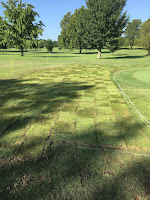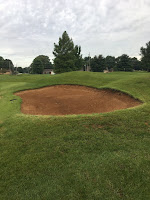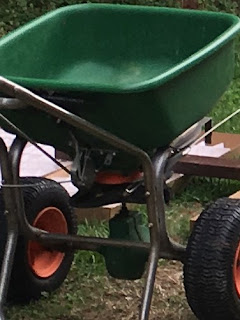Many of the zoysia approaches have faired ok over the years, some doing well, some not quite. In most cases, those that have not faired well, have multiple issues, but one as I have learned more about maintaining zoysia, in my opinion, most of the issues have had to do with irrigation coverage and surrounding terrain.
The two worst approaches we repaired this year have irrigation heads out in front of the green that need to run to water the front part of the green, I have learned over time, that zoysia really doesn't like quite as much irrigation as bentgrass greens in the transition zone. And while not large slopes for our area, we do have some terrain that sends water down across these approaches. Combine that with our maintenance equipment traffic and our cart traffic from golfers, these approaches had seen better days.


These are the before pictures of our 16th and 17th approaches and the edge of the bunker on 16. Looks like that bunker is a candidate for our next bunker renovation.
We stripped the poor sod off the approaches, added some dirt to level them, and then added fresh sod. We did water them lightly to keep them moist, and have added starter fertilizer to them. While we attempted this renovation a little late in the season, as we expected temperatures to start cooling off heading into September, (especially when we saw a week of below average temperatures, along with a forecast showing the same). We did get lucky in that once the sod was installed, we have been seeing our high temperatures for the day, stay in the 90's.



The first couple of pictures are the two approaches while work is in progress, the next three pictures show after the sod had been installed.
Our future goals are to better manage the greens irrigation by trying to do more hand watering, which is sometimes tough with our smaller crew and our ambitious work schedules. We also will visit our fertilizer and chemical programs to address the approaches. It isn't that easy to design a program for greens which includes a growth regulator program that is detrimental to collars, especially warm season ones. This has been why over the past few years we have been seeding with bentgrass into our zoysia and in some cases Bermuda collars. We have struggled with weeds in the collar area, as we have avoided applying pre-emergent herbicides, so we could have the bentgrass seed germinate. We are having to treat our collars which we are transitioning to cool season, different then our approaches which are warm season. The timing of applications and some of the products are so different for warm and cool season grasses in the transition zone, that sometimes for these small areas, I tend to miss applications due to weather conditions, other applications end up taking precedent on the golf course, or irrigation and/or mowing schedules hamper my plans.


We did have some extra sod left over, so we created a zoysia plot out in our turf farm. We have plots of fescue, Kentucky bluegrass, and Bermuda also. It allows us to repair any small damaged areas when we need to, also it allows us to try different products on the different turf.
We will look into improving at least two approaches a season from here on out, until all have been replaced, as needed. And we hope through trail and effort, and some education from industry sources. We can improve our approaches and collars.
As always,
Thanks for reading!
Mel

















































